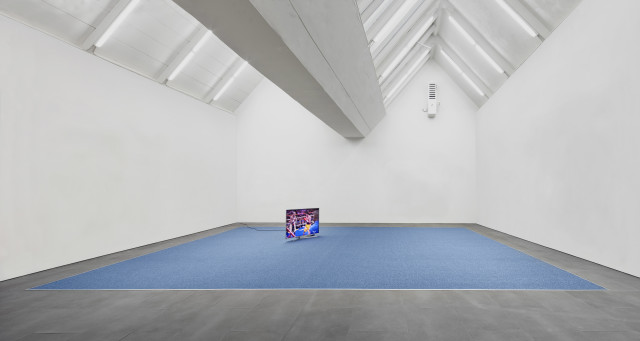
Paul Pfeiffer, Exhibition view at carlier | gebauer, 2016. courtesy of the artist and carlier | gebauer Photo: Gunter Lepkowski
Paul Pfeiffer
Three Figures in a Room
Carlier/Gebauer, Berlin
Until April 23, 2016
At least half the fun on any spectacle is the after-chat: the armchair philosophizing, the intention guessing, the interpretation, the endless acts of interpretation. The ancient Romans knew that much.
For instance, think of Beyonce’s recent Super Bowl performance, which is now generating MA theses, or Taylor Swift’s over-discussed Grammy speech, or, even more fleeting but just as worthy of spin-offs, that moment during the Golden Globes when Lady Gaga bumped into Leonardo Di Caprio – memes sprung up like freshly watered Sea Monkeys. (And, no, I hardly think it accidental that these three examples are all centred on people who present as female – women are still watched far more closely than men, because men still run the shows).
Paul Pfeiffer’s tri-part video installation, “Three Figures in a Room”, digs into this watch-analyse-watch again circle by distilling one world media event (a televised boxing match) to its core elements – sights and sounds. In a sequence of three chambers inside the Carlier/Gebauer gallery, each smaller than the next, the viewer is lead, like a tomb raider invading a burial chamber, from one enormous, sky-lit room into two much smaller, darkened and sound-proofed rooms.
As we make our progress through the labyrinth, the spectacle in play is first pulled apart and then painstakingly reworked. The effect of this degeneration and rebirth is both compelling and deliciously annoying. Annoying as in pestering. It affirms what we already suspect—that media spectacles are difficult to process, and full of their own tricks. Despite this obvious, shrugging assertion by Pfeiffer, though, his installation nevertheless draws you into its mediations and puzzle play. One must consider so many things – how a media spectacle is constructed, how easily spectacle can be re-jigged to become only about itself, its surface presentation, and then the opposite, how much grunt labour goes into such fleeting distractions. Oh, the head spins!

Paul Pfiffer, Exhibition view at carlier | gebauer, 2016. courtesy of the artist and carlier | gebauer Photo: Gunter Lepkowski
By the way, the spectacle in use is a televised boxing match held in Las Vegas between Floyd Mayweather and Manny Pacquiao. (Las Vegas is an appropriate setting, the city being the world capital of simulacra) The reason I have waited until now to describe in detail Pfeiffer’s core “text” is because I don’t think the actual content, mediated as it is, actually matters. Pfeiffer’s gaze has landed on sporting events in the past, but as sports are about as “actual” or “authentic” as any other manufactured entertainment, one assumes Pfeiffer could just as easily have chosen the Dina Shore Ladies PGA tournament or Eurovision for his meditations. It’s all one big blinking noisy spectrum of fakery and twinkling delights, and I mean that lovingly.
In the first very big room, Pfeiffer approximates a boxing ring with a square of blue carpet, on which sits a curved big-screen television. Scenes from the match play out but seem off somehow, time-lagged. Occasionally a boxer, or both, disappears, turns into fuzzy pixels. The individuals, the real life men hitting each other with real gloved fists, don’t matter, we come to understand – all that matters is the continuation of play, however it is presented.
In the second, much smaller room, the roar of the crowd watching the match has been pulled out of the soundtrack. We can hear the punches land, the sound of boxers dodging and sliding on the ring floor, and occasionally the cautions of the referee and, in one hard to observe moment, a coach berating Mayweather. These are people, Pfeiffer expects us to notice, people with voices and bodies – but only moments before, we were asked to, and quite willingly did regard the players as mere shapes in motion.
But “Three Figures in a Room” is hardly a lecture on humanism, as the next room, an intimate salon, shows us two small men sitting in their underpants in a cluttered room, watching the match as if their lives depended on it – or at least their livelihoods. The two men hold cloth bags which allow them to mimic the sound of gloved punches. Each playing one of the boxers, the men recreate the sounds of punches landing with their crude instruments. Later, on the men stands on a board and re-enacts the boxers’ steps.
Thus the circle is completed – from the first room’s devolution of two men hitting each other into clusters of pixels to the second room’s moment of humanization, of giving the players (granted, manipulated) voices and then back around to the third room, wherein we see the boxers as objects again, objects whose body sounds are fodder for manipulation. Nowhere in the three videos is it ever overtly acknowledged that we are watching two nearly naked men try to knock each other out, a staged but nevertheless brutal act of violence.
However, Pfeiffer’s dissection of the fight is not as clinical as it perhaps intends to be (the gallery’s press release describes the exhibition as “isolating representational codes”). Watching the fight, or rather Pfeiffer’s version of the fight, you cannot help but notice that you are watching a black man and an Asian man beat each other senseless for the entertainment of a front row audience comprised almost entirely of rich white men. And that is one “code” that is too vital and real-world impactful to exist in isolation.


Comments on this entry are closed.